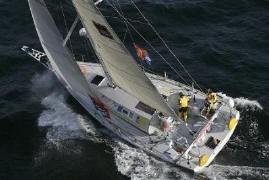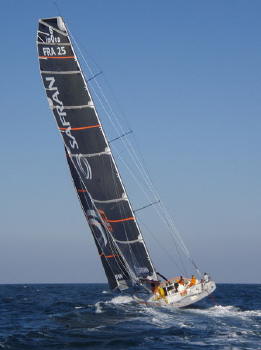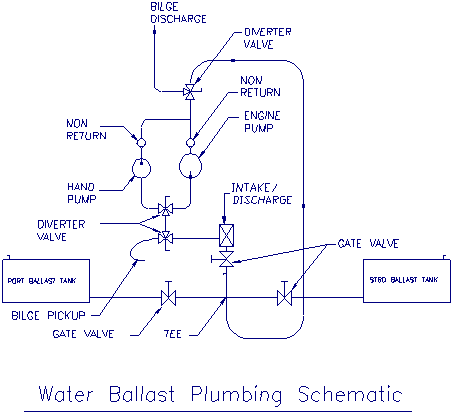Water Ballast….Race Boat Applications

Water ballast, in one form or another, has been around for the past 150 years. It has only been in the last 20 years that racing boats have utilized water ballast as a performance enhancing feature in their design criteria. We have seen this development primarily in the Open Class 30s, 40s, 50s, and 60s as well as the Whitbread 60s (Volvo 60s), and more recently, Class 40s. The use of water ballast has added to the strategy and excitement of these ocean racers and has become a proven, accepted feature as well as being reliable and safe.
Why does water ballast work? Like crew on the rail, water ballast adds weight outboard to increase a boat’s stability, or righting moment, helping it to sail more upright. This is important because a sailboat’s hull drag is usually the least when sailed upright. As the boat heels, hull drag increases and the boat slows down. Also, lift on the appendages decreases with an increase in heel angle, so the yacht’s pointing ability is reduced. It’s a similar principle for the sails as excessive heel will cause a reduction in lift and an increase in sail drag.
So when the seas are running and the breeze is heavy, a water ballasted yacht has a distinct advantage of being able to stabilize herself and become a more powerful offshore design. Sailing close-hauled in breeze is usually the time to carry the additional ballast as the boat will be heeling the most. Off the wind, it’s often more advantageous to sail with the tanks empty or partially full depending upon the conditions. However, if the wind and sea are running fairly high, then water ballast could be carried in both port and starboard tanks for proper weight and trim distribution. The extra weight of the water will keep the boat steady in waves. If the boat hobby-horses (pitch moment) too much, drag increases in both the rig and hull, and the boat’s efficiency through the water decreases dramatically.

If the water ballast tanks are divided into multiple compartments fore and aft, certain sections may be filled to correct for trim. These compartments would then be sub-divided with baffles to combat any free surface effects caused by the water sloshing back and forward. Depending upon the design, trial-and-error is necessary to optimize performance and develop a strategy for the use of the system for any given weather conditions. Even in light air conditions water ballast can be an advantage. By inducing heel the sails can hang full and continue to draw, keeping the boat going. The increased momentum created by the added weight also keeps the boat drifting forward when the puffs pass by.
When racing offshore or sailing shorthanded, classes like the Open 60s (left), Class 40s (above), and Mount Gay 30s have a full range of stability available via their water ballast tanks. This added righting moment gives the boat a marked performance increase in a variety of sea and wind conditions. The Mount Gay 30 Rule allows up to 600 litters of water ballast total. That is 300 litters each side, equivalent to 307.5 kgs per side. At 72.6 kgs per crew member, that’s equal to 4 1\4 crew members for on-the-wind conditions.
The stability characteristics of a Mount Gay 30 are a product of the Rules which define the boats dimensions: length, beam, draft, displacement, keel weight, keel center of gravity, mast weight, and mast center of gravity. The keel moment (keel weight times the distance between its center of gravity and the flotation waterplane) must be at least 1,180 kg-m which is easy to achieve for boats of normal proportions. However, in the unlikely event that the keel moment is less than this limit, then the boat must undergo a stability test. This involves pulling the boat over to 90 degrees heel and weighting the mast with 70 kgs (154.3 lbs) at the top of the jib halyard (IG measurement). The boat must at least balance this way, or preferably return upright, but not turn turtle. With such well-defined parameters, the 600 liter (158.5 gals) capacity of the water ballast tanks was determined as a safe and prudent amount.
The only design restrictions other than maximum capacity are that the tanks, which must be located aft of the chainplates, be integral or permanently secured to the hull, and be symmetrically arranged about the boats center line. The tanks must be plumbed with one system of pumps and valves. The pumps may be manual or powered. If power operated there must be a manual back-up. The inlets may be flush openings or retractable inlet scoops to take advantage of the ram effect at high speeds.

There are definitely strategic advantages to racing with water ballast, particularly on longer offshore competitions where there is little tacking to do. Water ballast can be taken on when you need it, you don’t have to feed it, it doesn’t talk back to you, and you can dump it when its usefulness has expired. The negative side is that, the plumbing requires some occasional maintenance and you don’t have as many warm bodies who can handle lines. Conversely, for round-the-cans racing where the ability to tack quickly is a necessity, dealing with water ballast become impractical. Crew weight, rather than transferring water, is far more efficient on these short, inshore courses as there are people to handle lines and reposition their weight for the best boat trim.
The system on the VG30 is quite simple and can be readily applied to boats of a similar size. Water is pumped on board with an electric pump or the hand pump backup. The 30 gpm electric pump may be brought on line at any time and takes approximately 2-1/2 minutes to fill a tank. The flow controls are located in the cockpit just forward of the traveler, providing quick and convenient access to the trimmer. The plumbing of the tanks is designed to be simple, easy to maintain, yet highly efficient. There are only three flow controls to this system; the 3″ dia. inlet/outlet gate valve, and two port and starboard gate valves for the 3″ dia transfer pipe. Two-way diverter valves are located down below to switch from the tank fill to a bilge pickup. The gate valves are all spring-loaded with shock cord (positive closed) and controlled lanyards leading up into the cockpit which can be held open by cam-cleating the lanyard in place.
Operating the water ballast system couldn’t be easier. To pump water into the port tank, the starboard and overboard gate valves are closed. Begin pumping until the port breather valves, located on the shear, blow water. To dump the water ballast, simply open the port and overboard gate valves, and the water will drain out with gravity. Tacking the VG30 with water ballast is just as easy. Prior to the tack, open both port and starboard gate valves, keeping the overboard gate valve closed, so the water will downflood from one side to the other. The transfer should take approximately 30 to 40 seconds, and once it is complete, close both gate valves and tack. It’s almost like roll tacking the boat! If there is any water loss, the new windward tank can be easily topped up with a few strokes on the hand pump.
